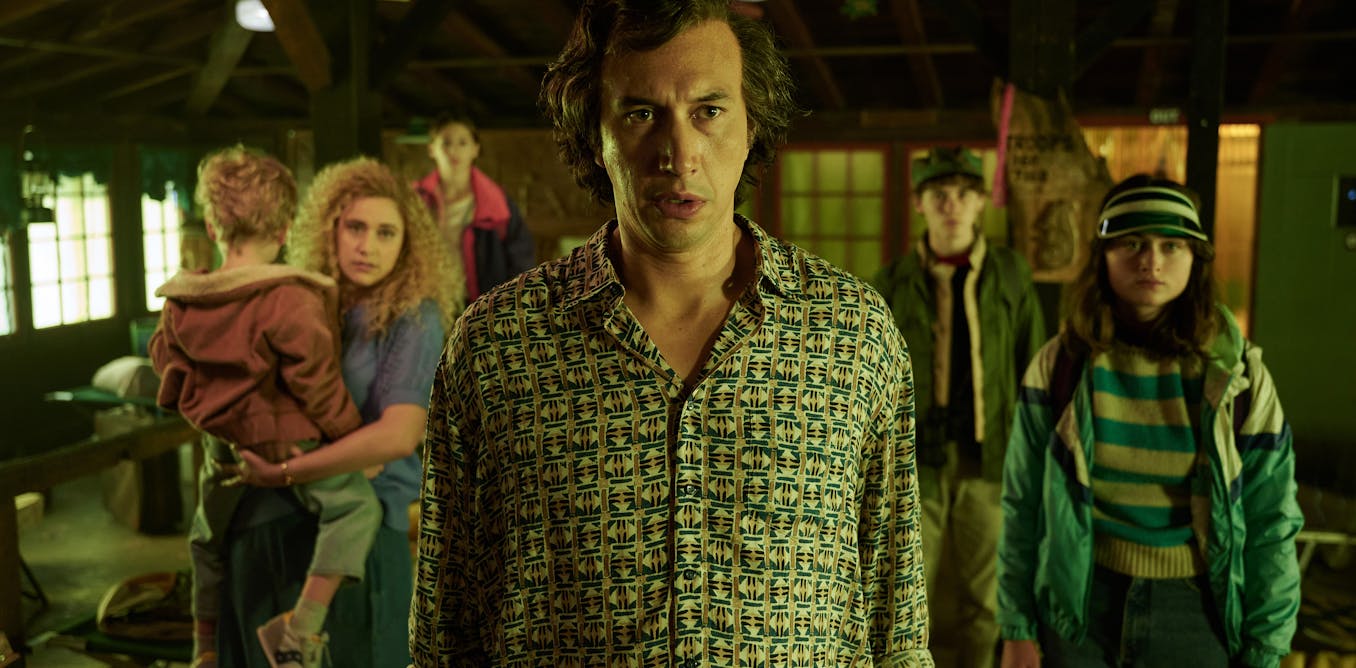
White Noise review – director Noah Baumbach skilfully captures Don Delillo’s ‘unadaptable’ novel
Never one to downplay the power of film, Stanley Kubrick once said that “almost every novel could be successfully adapted”. He carried this confidence into his own filmmaking, working not from original screenplays, but from adaptations of novels as different as William Makepeace Thackeray’s historical romp Barry Lyndon (1844) and Vladimir Nabokov’s erotic fantasy Lolita (1955).
Even Kubrick, however, allowed for the possibility of unfilmable fiction. Any novel can be adapted, he said, “provided it is not one whose artistic integrity is lost along with its length”.
The new screen version of American writer Don DeLillo’s 1984 novel White Noise, directed by Noah Baumbach, offers an interesting test case for Kubrick’s thesis.
Some, including the critic Michael Atkinson, think there is a fundamental conflict between the film and DeLillo’s literary practice. Writing in The Village Voice Atkinson argues: “No other living major American novelist has such a distinctive stylised voice in terms of dialogue and character”.
In assessing this adaptation of White Noise, however, we should not be so pessimistic. True, the film has its weaknesses, notably a baggy last third. But if Baumbach inevitably subtracts some things from DeLillo’s novel in reprocessing it for the screen, he adds others.
Focusing on just two of Baumbach’s creative inclusions allows us to assess the film’s strength and, more broadly, to test the post-war French film critic André Bazin’s argument that an adaptation and its source are not in conflict with each other. Rather, they are in conjunction, as two parts of what Bazin calls “an ideal construct”.
First and third persons
DeLillo’s White Noise follows Jack Gladney, who introduces himself as “chairman of the department of Hitler studies at the College-on-the-Hill”. The book follows his absurd life that is upended when an “airborne toxic event” makes him confront his mortality. Narrated in the first person, Jack describes a persistent sense of dread that undermines his academic activities, family commitments and consumer pleasures.
I woke in the grip of a death sweat. Defenceless against my own racking fears. A pause at the centre of my being.
The narrative voice is compelling for the reader, but also entrapping, with all of the other characters framed and filtered for us by Jack.
Baumbach’s White Noise tries intermittently to emulate such first-person storytelling. At times, the soundtrack includes voiceovers by Jack, played with characteristic excellence by Adam Driver. In other sequences, ambient sounds are muffled so as to magnify his anxious breathing and draw the viewer into his consciousness – to the exclusion of other figures.

Wilson Webb/Netflix
But more often, the adaptation has the opposite effect, opening things up and liberating spectators from the single perspective that prevails in DeLillo’s novel.
We are given greater access in particular to the thoughts and feelings of Jack’s wife Babette (Greta Gerwig). Several touching scenes, unregulated by Jack’s sensibility, show her looking on in anxiety or distress. While the cerebral quality of Jack’s narrative voice has thinned out, we have gained more emotional engagement.
“Blasts of colour”
Throughout his fiction, DeLillo is a careful colourist, attentive to hues and shades in the scenes he describes. “Orange” appears in the second sentence of White Noise and is succeeded, across the novel, by references to multiple colours from the emphatic (black or yellow) to the nuanced (sea-green or rose-white). “All the colours of the spectrum”, as Jack’s colleague Murray Siskind puts it, in a remark that Baumbach takes from DeLillo’s novel.
For all its sensitivity to the colour chart, however, White Noise on the page can only be black and white. Here, the film makes good a deficit and colourises the novel effectively. Baumbach and his cinematographer Lol Crawley opt for saturated colours: a plate of beans glows green, a truck carrying petrol pulses orange and a seedy motel’s neon signage is hellishly red.
Above all, there are the Day-Glo colours of consumer items: the yellow of a mustard jar, or the red of a ketchup bottle. These scenes that take place in the college’s cafeteria and in a brightly coloured supermarket bring to mind the photographs of William Eggleston, perhaps Americana’s pre-eminent visual archivist.
Thinking of Eggleston here bears out a point made by film scholar Thomas Leitch, that any adaptation is in dialogue with other cultural materials besides the source with which it shares a title.
White Noise the film engages in further conversations, too, that free it from affiliation only with DeLillo’s novel. As an intimate family portrait, for example, it makes an interesting pairing with Baumbach’s previous movie Marriage Story (2019), also starring Adam Driver.
Baumbach’s White Noise is respectful with regard to DeLillo’s novel, transferring plot and dialogue from the page with only modest amendments. It is not, however, excessively reverential.
In its bold cross-cutting and its closing dance number, for instance, and its emotional heightening and vivid colourisation, it offers us a second White Noise. Not one inevitably inferior to DeLillo’s version, but one existing alongside it. Book and film, in terms used by Bazin, contribute here to “a single work”, with the two art forms “equal in the eyes of the critic”.
